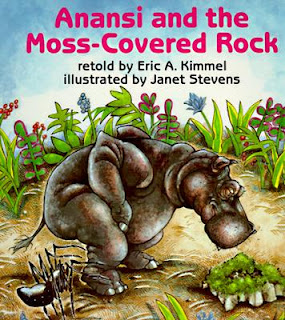Trivizas, Eugene. 1993. THE THREE LITTLE WOLVES AND THE BIG BAD PIG. Ill. by Helen Oxenbury. New York: Aladdin Paperbacks. ISBN 068981528X
Plot Summary
In this fractured fairy tale version of The Three Little Pigs, the roles of the wolf and pigs are reversed. In the beginning of this tale, the three little wolves are living with their mother, who decides that the time has come for her children to leave so they can build a house of their own. Although she warns them to watch out for the Big Bad Pig, the little wolves are not on their own for very long before they realize that he is determined to catch them. On three separate occasions, the three little wolves build a house, each time using stronger materials than the time before. After watching the Big Bad Pig destroy their houses made of bricks, concrete, and reinforced steel, the three little wolves decide to try a different approach to building - only this time, the only materials they use are flowers. Despite the fact that this new house was exceptionally delicate, the three little wolves decided to take their chances. When the Big Bad Pig finally arrives, his huffing and puffing force him to breathe in the lovely scent of all of the flowers, and ultimately leads him to a change of heart. The Big Bad Pig no longer wants to be bad when surrounded by all of those beautiful flowers, so he and the three little wolves decide that they can live happily ever after from that moment on.
Critical Analysis
 The Three Little Wolves and the Big Bad Pig is a wonderfully enchanting version of the traditional fairy tale. Eugene Trivizas has written an entertaining story while simultaneously retaining the charm of the original. Although the main characters have reversed roles, most of the original dialogue during their encounters has remained the same. The plot of this fractured fairy tale moves quickly, never taking a moment to slow the flow of action within the story. The surprising twist in the end is fulfilling when the reader learns that the Big Bad Pig has finally discovered the simple pleasures of friendship. As is typical of traditional tales, the main characters symbolically represent two very different ideals - kindness and cruelty. The rhythmic pattern of the language practically begs for this story to be read aloud to others. Helen Oxenbury's charming watercolor illustrations complement the story perfectly, for they are full of delightful and humorous details that will engage readers of all ages.
The Three Little Wolves and the Big Bad Pig is a wonderfully enchanting version of the traditional fairy tale. Eugene Trivizas has written an entertaining story while simultaneously retaining the charm of the original. Although the main characters have reversed roles, most of the original dialogue during their encounters has remained the same. The plot of this fractured fairy tale moves quickly, never taking a moment to slow the flow of action within the story. The surprising twist in the end is fulfilling when the reader learns that the Big Bad Pig has finally discovered the simple pleasures of friendship. As is typical of traditional tales, the main characters symbolically represent two very different ideals - kindness and cruelty. The rhythmic pattern of the language practically begs for this story to be read aloud to others. Helen Oxenbury's charming watercolor illustrations complement the story perfectly, for they are full of delightful and humorous details that will engage readers of all ages.Awards
- Grand Canyon Reader Award for Picture Book
- Pennsylvania Young Readers' Choice Awards for Grades K-3
- A Booklist Editors' Choice
- A School Library Journal Best Book
- A Parents' Choice Honor Book
Review Excerpts
“A menacing pig is thwarted by three endearing young wolves in this new twist on the porcine favorite. Three cheers for these frisky, frolicking creatures - and for the swine who learns the joy of friendship and beauty.” – School Library Journal
“A talented team ingeniously up-ends the classic tale of the three little pigs, and the laugh-out-loud results begin with the opening illustration...among the wittiest fractured fairytales around.” – Publishers Weekly
Connections
Reading this version of the well-known folktale provides a wonderful opportunity for children to act out the story by participating in a Reader's Theatre. You'll find a Reader's Theatre script that has already been created for The Three Little Wolves and the Big Bad Pig here.
This version of The Three Little Pigs could be included during a genre study of folktales. By reading many different versions of the same folktale, children will have the opportunity to practice comparing/contrasting as they determine what the versions have in common, as well as what differences they may have. The following titles include additional versions of the original folktale that could be incorporated into this unit of study.
This version of The Three Little Pigs could be included during a genre study of folktales. By reading many different versions of the same folktale, children will have the opportunity to practice comparing/contrasting as they determine what the versions have in common, as well as what differences they may have. The following titles include additional versions of the original folktale that could be incorporated into this unit of study.
- The Three Little Javelinas by Susan Lowell
- The Three Little Pigs and the Fox by William H. Hooks & S.D. Schindler
- The Three Cajun Pigs by Mike Artell and Jim Harris
- Alaska's Three Pigs by Arlene Laverde and Mindy Dwyer












